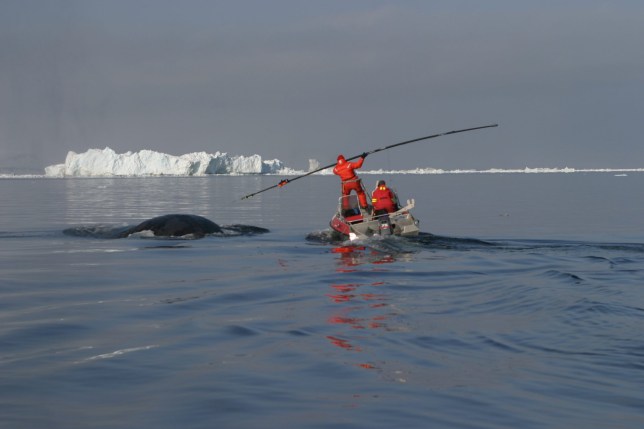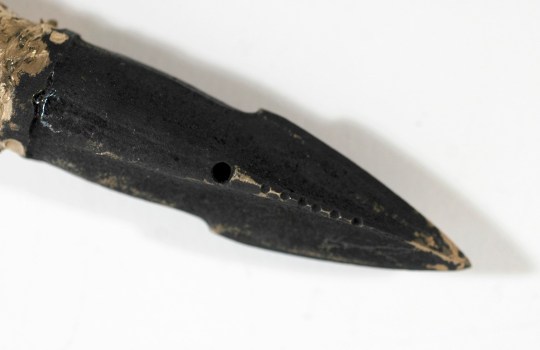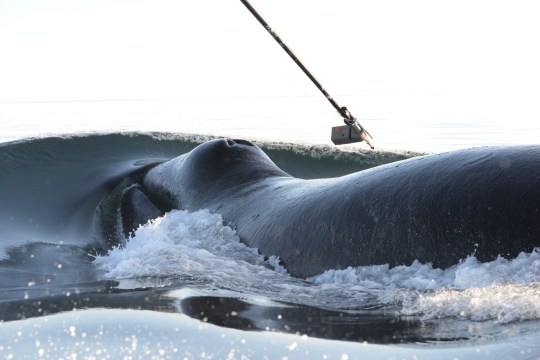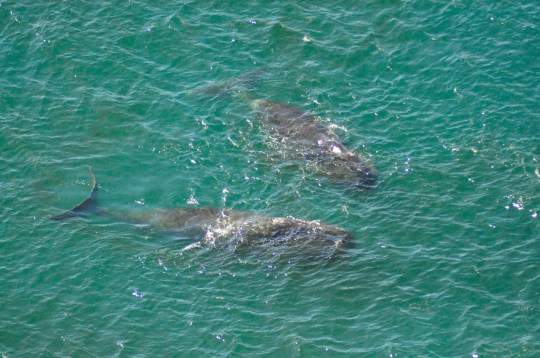A species of whale, so ancient and elusive that harpoon fragments dating back over a century have been discovered embedded in their bodies, continues to intrigue scientists.
The mysterious bowhead whale was first caught off the coast of Alaska, where it was found to have an arrowhead lodged in its neck.
Further research revealed it to be part of a 19th-century bomb lance, manufactured in New England around 1880. Although the weapon likely exploded upon impact, the whale’s thick layer of blubber and solid bones protected it from fatal injury, allowing it to live for another century.
John Bockstoce, curator at the New Bedford Whaling Museum in Massachusetts, said: ‘It probably hurt the whale, or annoyed him, but it hit him in a non-lethal place.
‘He couldn’t have been that bothered if he lived for another 100 years.’
The whale was believed to be around 130 years old at the time of capture- potentially making it the oldest living mammal on the planet.
Although bowhead whales remain largely mysterious, recent research has shed new light on their behaviours.
A team of divers from Japan’s Hokkaido University, Denmark’s Aarhus University, and the Greenland Institute of Natural Resources spent five months analysing the diving patterns of 12 tagged bowhead whales in Greenland’s Disko Bay.
The research revealed that these whales dive in synchrony, sometimes for as long as a week, even when separated by significant distances. This synchronised behaviour may be linked to acoustic communication, suggesting possible long-range communication between whales—a theory proposed more than 50 years ago.
Evgeny Podolskiy, an associate professor at Hokkaido University’s Arctic Research Centre, remarked, ‘The idea of acoustically connected whales, diving seemingly alone but actually in sync, is mind-blowing. Our research offers a framework for studying the social behaviours of these seemingly chaotic, free-roaming marine animals.’
Podolskiy expressed hope that the scientific community would continue gathering simultaneous tagging data to further expand upon these findings.
Bowhead whales are known for their large size and distinctive dark coloration, with a prominent white chin and a massive, triangular skull designed to break through Arctic ice.
As baleen whales, they are filter feeders, consuming krill, copepods, mysids, amphipods, and other small crustaceans by swimming with their mouths wide open.
Female bowheads tend to be larger than males, reaching lengths of up to 59 feet and weighing approximately 80 metric tons, while males average around 52 feet.
Not only are bowhead whales some of the largest mammals, but scientists also believe they are the longest-living, with an average lifespan of around 200 years. Genetic analysis conducted by researchers at CSIRO, Australia’s national science agency, suggests that these whales may live up to 268 years.
Despite their remarkable longevity, bowhead whales are considered endangered, with an estimated population of only 8,000 to 12,000 remaining. These whales travel in small pods, and their calves weigh as much as six tons at birth. Their primary threats are humans and orca whales.
Bowheads are equipped to survive in harsh Arctic conditions, with dense bones and a thick, foot-long layer of blubber that insulates them from freezing waters. This blubber, essential for keeping them warm, also acts as a natural shield against harpoon attacks.
Since 2001, six other whales have been discovered with similar harpoon fragments, further highlighting the extraordinary resilience of these ancient marine giants.
The whale in question was captured in 2007 by a commercial whaling crew, who discovered the fragment after cutting through its thick hide with a chainsaw.
Commercial whaling has since been banned worldwide due to an international agreement.
Get in touch with our news team by emailing us at webnews@metro.co.uk.
For more stories like this, check our news page.
MORE : Cat makes history by becoming first feline to complete Three Peaks Challenge
MORE : Keir Starmer risks upsetting No 10’s most-loved resident with latest move
MORE : Boy, 5, dragged by his head into woods by lion and mauled at family picnic
Get your need-to-know
latest news, feel-good stories, analysis and more
This site is protected by reCAPTCHA and the Google Privacy Policy and Terms of Service apply.


















